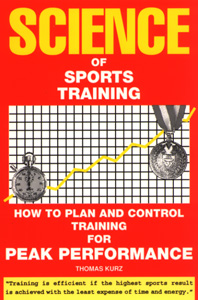by Thomas Kurz
Study these typical questions on training carefully. Among them may be just the one that you wanted to ask.
Question:
I have found your book both inspiring and very helpful with my flexibility training. I weight train four times per week and I do gymnastics twice per week. After I do leg exercises (leg presses, hack squats, but no regular squats due to the risk of injury) in my weight workout, my flexibility seems to go for about three to four days. Also my flexibility goes and then comes back again even without training. I do not know what causes it. I do not weight train excessively—one hour-and-a-half maximum per workout. I would like to achieve side and front splits and to be constantly flexible. Below I have written out my training schedule (obviously I am doing something wrong).
Sunday: Gymnastics (workout ends with relaxed stretches)
Monday: Weights (workout ends with static active flexibility exercises followed by isometric stretches)
Tuesday: Weights (workout ends with relaxed stretches)
Wednesday: Gymnastics (workout ends with relaxed stretches)
Thursday: Weights (workout ends with relaxed stretches)
Friday: Weights (workout ends with isometric stretches)
Saturday: Rest
Answer:
You did not tell me what exercises you do in your gymnastic workouts, how much you lift, on what days you do which lifts, and risk of what injury keeps you from doing squats. Did you have an injury that could reoccur if you did squats or are you just afraid of injuring yourself because you don’t know how to do squats? In the latter case the remedy is to learn the correct form, which is is taught one easy step at a time on Flexibility Express DVD. BTW, each exercise shown on Flexibility Express will build your muscles while increasing your flexibility, saving both your time and energy–unlike the usual stretches that give minimal flexibility that doesn’t last.
Your problem may be caused by doing leg exercises too often, or not often enough (because you get too tired doing them), and/or not in the full range of motion (because you don’t do squats). Here is a weekly schedule of workouts that you may want to try, to see if it helps with your flexibility problems.
Sunday: Gymnastics–dynamic stretches in the warm-up; static active as needed; at the end of the workout, do isometric stretches for side splits with moderate tensions or, if legs too tired, do only relaxed stretches
Monday: Weights–adductor exercises, deep squats (if impossible then hack squats), good mornings or deadlifts, back extensions; do isometric stretches with strong tensions for side split either after adductor exercises or after squats but before lower back exercises
Tuesday: Weights–arms, chest, upper back—use exercises that do not put compressive loads on your spine; end workout with relaxed stretches
Wednesday: Gymnastics–dynamic stretches in the warm-up; static active as needed; at the end of workout do isometric stretches for side splits with moderate tensions or, if legs too tired, do only relaxed stretches
Thursday: Weights–adductor exercises, deep squats (if impossible then hack squats), good mornings or deadlifts, back extensions; do isometric stretches with strong tensions for side split either after adductor exercises or after squats but before lower back exercises
Friday: Weights–arms, chest, upper back—use exercises that do not put compressive loads on your spine; end workout with relaxed stretches
Saturday: Rest
(Read about another workout in the next article.)
Resources for Further Study
Flexibility Express: Flexibility and Functional Strength in No Time
Image may be NSFW.
Clik here to view.
This easy-to-follow DVD offers a proven method of increasing your range of motion while increasing your strength—whatever your age or flexibility level.
You will learn innovative functional exercise progressions from weighted squats to splits and back bridges. Each exercise will build your muscles while increasing your flexibility, saving both your time and energy. The saved time and energy then can be used for more and better practice of your skills.
Science of Sports Training: How to Plan and Control Training for Peak Performance
Image may be NSFW.
Clik here to view.
This comprehensive text delves deeply into topics such as speeding up recovery, using time- and energy-efficient training methods, avoiding overtraining and injuries, applying proven methods of training to specific sports, and maintaining a high level of condition and skills for years. You will learn ways to plan and control training for each workout, over a span of years.
Secrets of Stretching: Exercises for the Lower Body
Image may be NSFW.
Clik here to view.
This DVD features an introduction to general conditioning and follows that with four exercise routines—one for beginners, one for intermediate, and two for advanced athletes. Viewers will learn plenty of how-tos. The focus is on flexibility and strength training.
If you have any questions on training you can post them at Stadion’s Sports and Martial Arts Training Discussion Forum